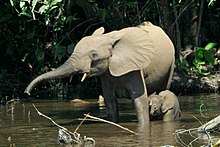
Back Afrika-woudolifant AF Loxodonta cyclotis AN فيل الغابات الإفريقي Arabic فيل الغابات الافريقى ARZ Fuzol (Loxodonta cyclotis) AVK Afrika meşə fili AZ Лясны афрыканскі слон BE Лясны афрыканскі слон BE-X-OLD Африкански горски слон Bulgarian Olifant koadoù Afrika BR
| African forest elephant Temporal range: Pleistocene–Recent
| |
|---|---|

| |
| African forest elephants in Nouabalé-Ndoki National Park | |
| Scientific classification | |
| Domain: | Eukaryota |
| Kingdom: | Animalia |
| Phylum: | Chordata |
| Class: | Mammalia |
| Order: | Proboscidea |
| Family: | Elephantidae |
| Genus: | Loxodonta |
| Species: | L. cyclotis[1]
|
| Binomial name | |
| Loxodonta cyclotis[1] (Matschie, 1900)
| |

| |
| Range of the African forest elephant[2] Resident Possibly Extant (resident) Possibly extinct
| |
The African forest elephant (Loxodonta cyclotis) is one of the two living species of African elephant, along with the African bush elephant. It is native to humid tropical forests in West Africa and the Congo Basin. It is the smallest of the three living elephant species, reaching a shoulder height of 2.4 m (7 ft 10 in). As with other African elephants, both sexes have straight, down-pointing tusks, which begin to grow once the animals reach 1–3 years old. The forest elephant lives in highly sociable family groups of up to 20 individuals. Since they forage primarily on leaves, seeds, fruit, and tree bark, they have often been referred to as the 'megagardener of the forest'; the species is one of many that contributes significantly to maintaining the composition, diversity and structure of the Guinean Forests of West Africa and the Congolese rainforests. Seeds of various plants will go through the elephant's digestive tract and eventually pass through in the animal's droppings (likely in a new location where they will sprout), thus helping to maintain the spread and biodiversity of the forests.
The first scientific description of the species was published in 1900. During the 20th century, overhunting caused a sharp decline in population, and by 2013 it was estimated that fewer than 30,000 individuals remained. It is threatened by habitat loss, fragmentation, and poaching. The conservation status of populations varies across range countries. Since 2021, the species has been listed as Critically Endangered on the IUCN Red List.[2]
- ^ Shoshani, J. (2005). "Loxodonta cyclotis". In Wilson, D.E.; Reeder, D.M (eds.). Mammal Species of the World: A Taxonomic and Geographic Reference (3rd ed.). Johns Hopkins University Press. p. 91. ISBN 978-0-8018-8221-0. OCLC 62265494.
- ^ a b c d Gobush, K.S.; Edwards, C.T.T.; Maisels, F.; Wittemyer, G.; Balfour, D.; Taylor, R.D. (2021) [errata version of 2021 assessment]. "Loxodonta cyclotis". IUCN Red List of Threatened Species. 2021: e.T181007989A204404464. doi:10.2305/IUCN.UK.2021-1.RLTS.T181007989A204404464.en.
